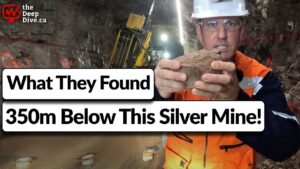BOWMORE Exploration Ltd. (TSX VENTURE:BOW) (“Bowmore” or “the Company”) is pleased pleased to announce the results from its summer drilling campaign on the Chivas property, located in Sonora province, Mexico. The drilling outlined a new hydrothermal mineralized breccia structure at Mesa Blanca, and also extended laterally and at depth the Piedra Rodante high grade low-sulfidation structure discovered by Amex’s Mexican subsidiary ‘Minerales X-Ore’ in 2006.
This first phase of drilling consisted of 7 drill holes totaling 2065.4 meters to test portions of the epithermal system discovered in 2011 (see press Release April 13, 2011) and to test the high grade gold-silver veins from the Piedra Rodante zone.
Highlights include:
High grade gold-silver veins where cut at the Piedra Rodante zone in holes:
- Hole NS-12-07
Individual sections intersected, included 12.85 g/t Au and 444.0 g/t Ag over 1.5 meters.
- Hole NS-12-06
Individual sections intersected, included, 8.42 g/t Au and 85.9 g/t Ag over 3 meters and ;
- Hole NS-12-05
Individual sections intersected included 5.83 g/t Au and 147.0 g/t Ag over 1.4 meters;
All of these intersects are contained within much larger, lower grade breccia-type structures that returned: 0.62 g/t Au and 32.5 g/t Ag over 72.00 meters in hole NS-12-07; 1.11 g/t Au and 17.4 g/t Ag over 28.7 meters in hole #NS-12-06; 0.48 g/t Au and 44.6 g/t Ag over 62.0 meters in hole #NS-12-05 (see table #1).
Table 1
| Summary of Drill Hole Results 2012 – CHIVAS | ||||||
| Drill Hole | From (m) | To (m) | Width (m)* | Au g/t | Ag g/t | |
| NS12-05 | 109.00 | 171.00 | 62.00 | 0.48 | 44.6 | |
| Includes | 109.00 | 115.65 | 6.35 | 1.13 | 232.4 | |
| Includes | 109.00 | 110.50 | 1.50 | 1.24 | 721.0 | |
| From | 143.50 | 171.00 | 27.50 | 0.59 | 30.2 | |
| Includes | 143.50 | 155.50 | 12.00 | 1.17 | 57.0 | |
| Includes | 148.00 | 151.00 | 3.00 | 3.86 | 117.1 | |
| Includes | 149.60 | 151.00 | 1.40 | 5.83 | 147.0 | |
| NS12-06 | 43.00 | 80.00 | 37.00 | 0.87 | 13.2 | |
| Includes | 48.30 | 77.00 | 28.70 | 1.11 | 17.4 | |
| Includes | 49.50 | 66.50 | 17.00 | 1.77 | 26.0 | |
| Includes | 51.00 | 54.00 | 3.00 | 8.42 | 85.9 | |
| NS12-07 | 131.50 | 203.50 | 72.00 | 0.62 | 32.5 | |
| Includes | 176.50 | 199.00 | 22.5 | 1.90 | 94.2 | |
| Includes | 184.95 | 196.00 | 11.05 | 3.71 | 175.8 | |
| Includes | 189.00 | 195.00 | 6.00 | 5.87 | 244.4 | |
| Includes | 190.50 | 192.00 | 1.50 | 12.85 | 444.0 | |
*apparent width
Paul A. Dumas President and CEO of Bowmore and Jacques Trottier President and CEO of Amex commented: “We are very excited with the results of this first phase drill program, with very limited drilling, we have successfully demonstrated the lateral and at depth extensions of the Piedra Rodante zone and, second, made a new discovery at Mesa Blanca. Even though gold and silver values at Mesa Blanca are thus far low, they are good indicators that we are above a much larger system, and possibly be connected with the Piedra Rodante to the north. Only deeper drilling of this new hydrothermal low-sulfidation structure will demonstrate its economic potential. Furthermore we still have not tested the “Mesa” and “Cerro Rojo” zones to the NNW of the Piedra Rodante zone whereas several indicators of the epithermal system are still present.”
The structure of the Piedra Rodante zone, where the mineralization is emplaced in a N005W fault with 60-62°dip toward the East, is known in outcrops and in various drill holes over a strike length of about 1,000 meters and to a depth of 240 meters, and is still open below this level. The mineralized structure presents a low grade envelope, 10 to 20 m wide, of >1 g/t Au and >100 g/t Ag that include 1.5 to 6 meter wide intervals with grades greater than 8 g/t Au and >350 g/t Ag. The paragenesis of the mineralization includes an early stage of marcasite-pyrite with low silica content followed by a pulse of hydrothermal breccia. This breccia presents clasts of the volcanic host rock, and sulfide fragments of the early sulphide event cemented by a hydrothermal matrix composed by bands of chalcedonic silica, and py-marcasite-arsenopyrite with colloform – crustiform texture. The total content of sulfides doesn’t exceed 5% volume. The silicate-alteration-epithermal minerals observed within the best-mineralized zone include illite-sericite, illite-smectite (the two micas assemblage), probably white fine-grained adularia, and carbonate minerals that had been leached.
Down dip, the vein of Piedra Rodante is marked by a low grade mineralized envelop that surrounds the high-grade vein-breccia zone. Within the low grade mineralized envelop there is a high grade zone that continues within the 240 meter known vertical section, including 3 to 6 m intervals with Au equivalent values between 5.8 g/t and 9.94 g/t. The best-mineralized interval was intersected in the deepest drill hole with 6 m of 9.94 g/t Au eq., including 1.5m of 20.3 g/t Au eq. The Ag: Au ratios do not present a clear vertical zoning, with values varying between 40 and 140. (A ratio of 60 has been used to convert Ag into Au equivalent values)
The other zone of interest (as described in the Press Release dated May 17th 2012) is called ‘Mesa Blanca’, where high resistivity anomalies at the sub-surface were found, indicating the presence of anomalous gold and silica associated with disseminated sulphides. It also corresponded to previous surface sampling and identification of high silicification and a large area of anomalous buddingtonite from the TerraSpec sampling program done in early 2011.
Results from the two holes drilled to test this target (NS-12-03 and NS-12-04), are separated by about 550 meters and are quite similar. This target is located at about 1000 meters SSE of the Piedra Rodante zone. Both have cut a brecciated silicified zone that is similar to the breccia observed in outcrops and contain clasts of the volcanic host rock cemented by fine-grained silica red matrix. Gold grades >1g/t are associated with the injection of py-marcasite and chalcedonic silica within the breccia. Drill hole NS-12-03 was drilled in this area and intercepted a structure with 20.5 meters @ 0.1 g/t Au, 0.5g/t Ag, 204 ppm As and 15 ppm Sb at around 110 m from the current surface, and drill hole # NS-12-04 intersected a similar structure with 18.75 meters @ 0.07 g/t Au, 1.3 g/t Ag, 275 ppm As and 13 ppm Sb at about 200 meters below the current surface.
The Chivas Property is composed of 2 exploration titles covering over 24,841 hectares and is located within the Sierra Madre Occidental gold belt (“SMO”). The SMO is known to host reserves of more than 40 Million ounces of gold and 2 Billion ounces of silver. The Chivas property, optioned from Amex Exploration Inc. (AMX: TSX-V, “Amex”) is 15 kilometers to the west of the Dolores Mine previously owned by Minfinders Corporation Ltd. and now Pan American silver Corp. The earn-in option provides Bowmore the right to acquire up to 70% interest in the property (see news release dated April 8, 2010.
Amex and Bowmore managements are very enthusiastic about the results of this first drilling campaign on the property located in the prolific Sierra Madre gold belt.
Bowmore follows strict QA-QC protocol measures in keeping with industry standards and regulatory reporting requirements. All drill cores was processed using descriptive logging and systematic sampling for analysis. NQ core samples were cut in half, with one half delivered to a commercial laboratory and the other half retained for future reference. Duplicates, blanks and standards were inserted into the sample sequence. Lost core within mineralized intersections (generally less than 1%) were incorporated as blank intervals. All samples were prepared and analyzed at the facilities of ALS Chemex Hermosillo, Mexico and pulps sent to ALS Chemex Vancouver. Gold content was first analyzed utilizing standard fire assay fusion of a 50 gram charge, followed by Atomic Absorption Spectroscopy (Au 50g FA AA finish). For those samples that yielded assays greater than 10 ppm Au (10 g/t Au), the samples were assayed again utilizing standard fire assay fusion, followed by gravimetric analysis (Au 50g FA-GRAV finish). All other elements, including silver, were analyzed utilizing Inductively Coupled Plasma – Atomic Emission Spectroscopy (35 Element Aqua Regia ICP AES) methods, on a prepared sample digested with aqua regia. For those samples that yielded assays greater than 100 ppm Ag (100 g/t Ag), the samples were assayed again by the default over limit method Ag Ore grade Ag – Aqua Regia. The reader is directed to ALS Chemex website for more details:
http://www.alsglobal.com/minerals/downloads/short-method-descriptions.aspx.
Jean-Marie Pronovost, P. Geo, principal geologist for Bowmore, is the Qualified Person who has reviewed this news release and is responsible for the technical information reported herein.
About BOWMORE
BOWMORE is a Canadian exploration mining company focused on precious metal exploration in Canada and Mexico. The Company trades on the TSX Venture Exchange under the symbol “BOW”.
Forward-looking statements:
Except for statements of historical facts, all statements in this news release regarding, without limitation, the Private Placement, new project acquisitions, future plans and objectives are forward-looking statements which involve risks and uncertainties. There can be no assurance that such statements will prove to be accurate. Although the Company believes the expectations expressed in such forward-looking statements are based on reasonable assumptions actual results and future events could differ materially from those anticipated in such statements. Factors that may cause the actual results to differ materially from those in forward-looking statements include precious metal prices, results of exploration and development activities, regulatory changes, defects in title, availability of materials and equipment, timeliness of government approvals, continued availability of capital and financing and general economic, market or business conditions. The Company cautions the foregoing list of important factors is not exhaustive. Investors and others who base themselves on the Company’s forward-looking statements should carefully consider the above factors as well as the uncertainties they represent and the risk they entail. Please see the public filings of the Company at www.sedar.com.
Neither TSX Venture Exchange nor its Regulation Services Provider (as that term is defined in the policies of the TSX Venture Exchange) accepts responsibility for the adequacy or accuracy of this release.

















